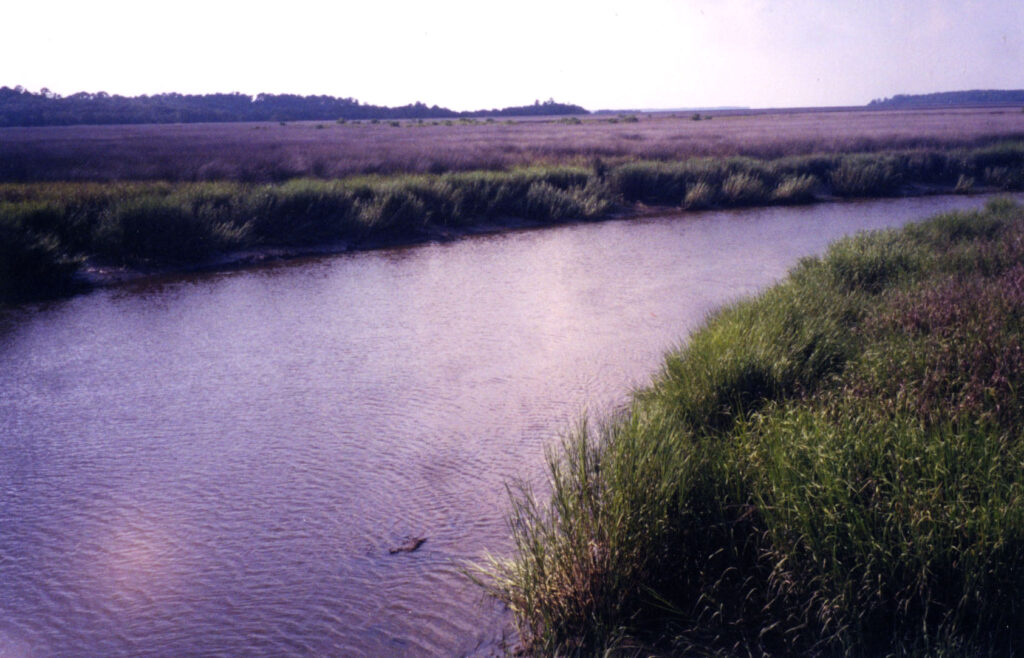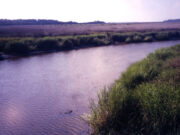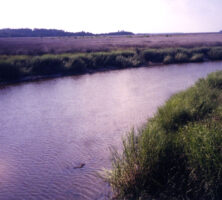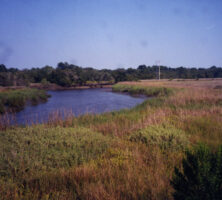The story that gives Ebos Landing its name is one of the most colorful and enduring tales in Georgia’s rich literary history. Better known as the “Myth of the Flying Africans,” this narrative has been told and embellished for 200 years in the form of local legends, children’s stories, movies, novels, and television shows. Based on an actual historical event, this remarkable tale of an Ebo (also known as Igbo or Ibo) slave rebellion on St. Simons Island has become a powerful metaphor of African American courage, longing, and conviction.

Photograph by Elisabeth Hughes, New Georgia Encyclopedia
The historical roots of the flying Africans legend can be traced back to the spring of 1803, when a group of Igbo captives arrived in Savannah after enduring the nightmare of the Middle Passage. The Igbo (from what is now the nation of Nigeria, in central West Africa) were renowned throughout the American South for being fiercely independent and unwilling to tolerate the humiliations of chattel slavery. The Igbo who became known as the flying Africans were purchased at the slave market in Savannah by agents working on behalf of John Couper and Thomas Spalding. Loaded aboard a small vessel, the Igbo were confined below deck for the trip down the coast to St. Simons. During the journey, however, the Igbo rose up in rebellion against the white agents, who jumped overboard and were drowned.
What happened next is a striking example of the ways in which enslaved African Americans and white enslavers interpreted “history” in starkly different terms. One of the only contemporary written accounts of the event was by Roswell King, a white overseer on the nearby plantation of Pierce Butler. King recounted that as soon as the Igbo landed on St. Simons Island, they “took to the swamp”—committing suicide by walking into Dunbar Creek. From King’s perspective the salient feature of the story was the loss of a substantial financial investment for Couper and Spalding.
African American oral tradition, on the other hand, has preserved a very different account of the events that transpired that day. As with all oral histories, the facts of the story have evolved as storytellers elaborated the tale over the years, such that there are now dozens of variations on the original episode. In the late 1930s, more than 100 years after the Igbo uprising on St. Simons, members of the Federal Writers Project collected oral histories in the Sea Islands (many of which can now be found in Drums and Shadows: Survival Studies among the Georgia Coastal Negroes). An older African American man by the name of Wallace Quarterman was asked if he had heard the story of Ebos landing. Quarterman replied:
Ain’t you heard about them? Well, at that time Mr. Blue he was the overseer and . . . Mr. Blue he go down one morning with a long whip for to whip them good. . . . Anyway, he whipped them good and they got together and stuck that hoe in the field and then . . . rose up in the sky and turned themselves into buzzards and flew right back to Africa. . . . Everybody knows about them.
This account of transforming the hardships of slavery into the magical powers of freedom has been retold by a distinguished array of African American artists throughout the last century. Virginia Hamilton and Julius Lester rendered the tale for children. Julie Dash celebrated the memory of Ebos Landing in elegant visual terms with her film Daughters of the Dust (1991). Perhaps most important, Nobel Prize–winning writer Toni Morrison used the myth of the flying Africans as the basis for her novel Song of Solomon (1977).
Morrison’s literary masterpiece recounts the story of a young African American man, Milkman Dead, who has been crippled by persistent racism and limited opportunities. Having grown up in the industrialized North, Milkman returns to the South in search of his ancestral roots. In the course of his travels, he learns from oral histories that his family is descended from an African shaman who possessed the power of flight. Having regained the knowledge of his family and his African heritage, Milkman recovers his lost ancestral powers at the end of the novel and takes flight at what appears to be the moment of his death. This soaring climax fittingly captures the power, hope, and magic inherent in the myth of the flying Africans and offers an important insight into why this tale has been cherished for so long. By transforming the painful memories of slavery and racism into the emancipating power of flight, the story of the flying Africans continues to play an important role in maintaining a cultural connection to Africa and empowering generations of Black Americans.
Although the myth of the flying Africans will undoubtedly be told for many decades to come, a fitting coda to this tale might be found in the consecration of Ebos Landing in the summer of 2002. The St. Simons African-American Heritage Coalition invited Chukwuemeka Onyesoh from Nigeria to designate Ebos Landing as holy ground and to put the souls of the enslaved to rest. “I came here to evoke their spirits,” Onyesoh explained, “to take them back to Igboland.” Participants in the memorial traveled from Haiti, Belize, Canada, New York, and Mississippi, among other places to watch and pray as elder Igbo tribesman danced and sang under the aging cypress trees hung with moss.
No historical marker commemorated the site of Ebos Landing, which is adjacent to a 1940s-era sewage treatment plant, until 2022. The African American community also continues to mark the sacred site in their own, more private ways. Some local fishermen on St. Simons, for example, will not cast fishing lines or crab nets in the fecund waters of Dunbar Creek for fear of disturbing the ghosts of the Igbo. While the state waited years to recognize Ebos Landing as a landmark, the many stories ranging from folktales to Nobel Prize–winning novels surely constitute a kind of literary memorial worthy of the remarkable story of the flying Africans.








